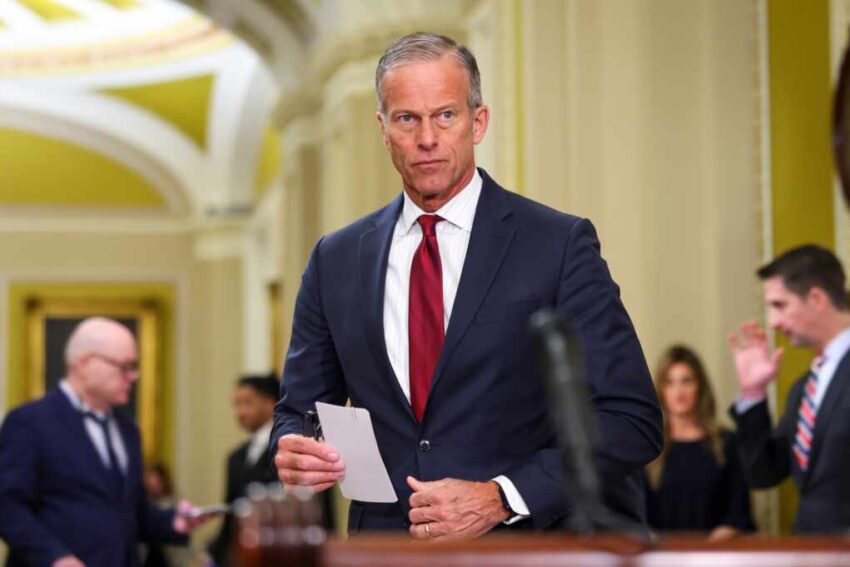Senate Majority Leader John Thune’s openness to recess appointments has reignited a constitutional debate as the Trump administration faces a mounting backlog of nominees, with the House using procedural tactics to block the Senate from recessing long enough for the President to act unilaterally.
Story Snapshot
- Thune signals possible use of recess appointments to address stalled Trump nominees
- The House, under Speaker Mike Johnson, is holding pro-forma sessions to block Senate recess
- Supreme Court precedent and constitutional limits sharply constrain recess appointment power
- The standoff reflects deepening partisan gridlock and raises questions about Senate norms
Thune Considers All Options Amid Nominee Backlog
Senate Majority Leader John Thune has not ruled out the use of recess appointments to move forward a pipeline of President Trump’s stalled nominees. As of early 2025, the Senate faces a significant backlog due to persistent partisan gridlock. Thune recently stated, “I think everything is on the table,” making clear that no procedural tool is off limits as the administration’s efforts to fill critical executive and judicial vacancies are hamstrung by delays in the upper chamber. However, the House, led by Speaker Mike Johnson, continues to hold pro-forma sessions every three days, preventing the Senate from entering a recess of sufficient length for any appointments to be made without Senate approval.
https://twitter.com/benjaminuover
Under the Constitution, recess appointments allow the President to temporarily fill vacancies when the Senate is not in session, but this power now faces major practical and legal obstacles. The most critical is the requirement that both the House and Senate agree to an adjournment of more than three days; otherwise, pro-forma sessions can be used to technically keep Congress in session and block the President from acting. This maneuver, now widely used, has become central to the standoff between chambers and parties.
Watch: Trump’s Waiting on the Senate for Nominee Confirmations – YouTube
Supreme Court Precedent Limits Executive Power
The Supreme Court’s 2014 decision in NLRB v. Noel Canning sharply limited the President’s ability to make recess appointments, ruling that pro-forma sessions are sufficient to prevent the Senate from being considered in recess. As long as the House continues to block a formal adjournment, the Senate cannot recess for the ten days required to trigger the President’s constitutional authority for unilateral appointments. Legal scholars widely agree that, while the Recess Appointments Clause was intended as a practical solution for government function in the 18th century, today’s Congress has effectively neutralized it through procedural tactics. Both parties have used and opposed recess appointments, depending on who controls the White House and Senate, but recent years have seen the practice become increasingly controversial and constrained.
Senate Minority Democrats have signaled their strong opposition to any attempt by President Trump to circumvent the standard confirmation process. Some experts have also warned that an aggressive use of recess appointments, especially in the current climate, could trigger further legal challenges or even another Supreme Court intervention. The constitutional method for appointments remains Senate advice and consent, with recess appointments regarded as a narrow exception that should not be the norm.
Partisan Gridlock and Procedural Brinkmanship Escalate
The dynamic between the House and Senate is now defined by procedural brinkmanship, with Speaker Johnson’s use of pro-forma sessions serving as a direct check on executive power. This tactic, originally designed to maintain legislative oversight and prevent what critics label as executive overreach, has contributed to a climate of heightened partisanship and legislative dysfunction. For the Trump administration, the inability to fill key positions in federal agencies and the judiciary not only hampers policy goals but also risks further public frustration with government inefficiency.
The current standoff is emblematic of broader trends in Washington. Gridlock has become a defining feature of Congress, and the willingness of leaders like Thune to consider all constitutional options—however constrained—reflects mounting GOP frustration with procedural obstacles and Democratic resistance. For conservatives, the use of recess appointments is less about executive fiat and more about ensuring government function in the face of what many see as deliberate obstruction. The American public, especially those who value constitutional checks and balances, are watching closely to see whether these powers will be exercised or further curtailed by legal precedent and legislative gamesmanship.
Implications for the Future of Constitutional Governance
The outcome of this standoff could reshape the way future administrations approach appointments and may set new precedents for the interplay between congressional procedure and executive authority. If the Senate and House remain locked in procedural combat, critical agencies and the courts could continue to operate with significant leadership gaps, affecting everything from regulatory enforcement to national security. Such dysfunction risks further eroding public trust in government and could fuel calls for reform of the existing process.
Experts agree that the core constitutional mechanism for appointments is Senate confirmation, not unilateral executive action. However, the increasing use of pro-forma sessions and the willingness of leaders to push constitutional boundaries highlight the need for a renewed commitment to transparency, cooperation, and the rule of law. While recess appointments remain on the table, their use has never been more constrained—or more politically contentious—than in today’s climate of divided government and heightened scrutiny.
Click this link for the original source of this article.
Author: Editor
This content is courtesy of, and owned and copyrighted by, https://thecongressionalinsider.com and its author. This content is made available by use of the public RSS feed offered by the host site and is used for educational purposes only. If you are the author or represent the host site and would like this content removed now and in the future, please contact USSANews.com using the email address in the Contact page found in the website menu.








